OB Reading Journal: Leadership, Teamwork, and Decision-Making
VerifiedAdded on 2022/08/16
|9
|2367
|15
Report
AI Summary
This report is a comprehensive reading journal exploring key concepts in organisational behaviour, including leadership, team building, and decision-making processes. The student reflects on various leadership styles, such as autocratic, democratic, and situational leadership, and relates them to personal experiences and theoretical frameworks like McGregor's Theory X and Y and Hersey and Blanchard's situational leadership. The journal also analyzes team dynamics, conflict resolution, and the importance of effective communication and mediation in resolving conflicts within a team. Furthermore, the report delves into the process of decision-making, examining the influence of different paradigms and the significance of considering diverse perspectives to enhance creativity and employee engagement within an organisation. The student incorporates personal experiences, class discussions, and theoretical frameworks to provide a thorough understanding of these organisational behaviour concepts.
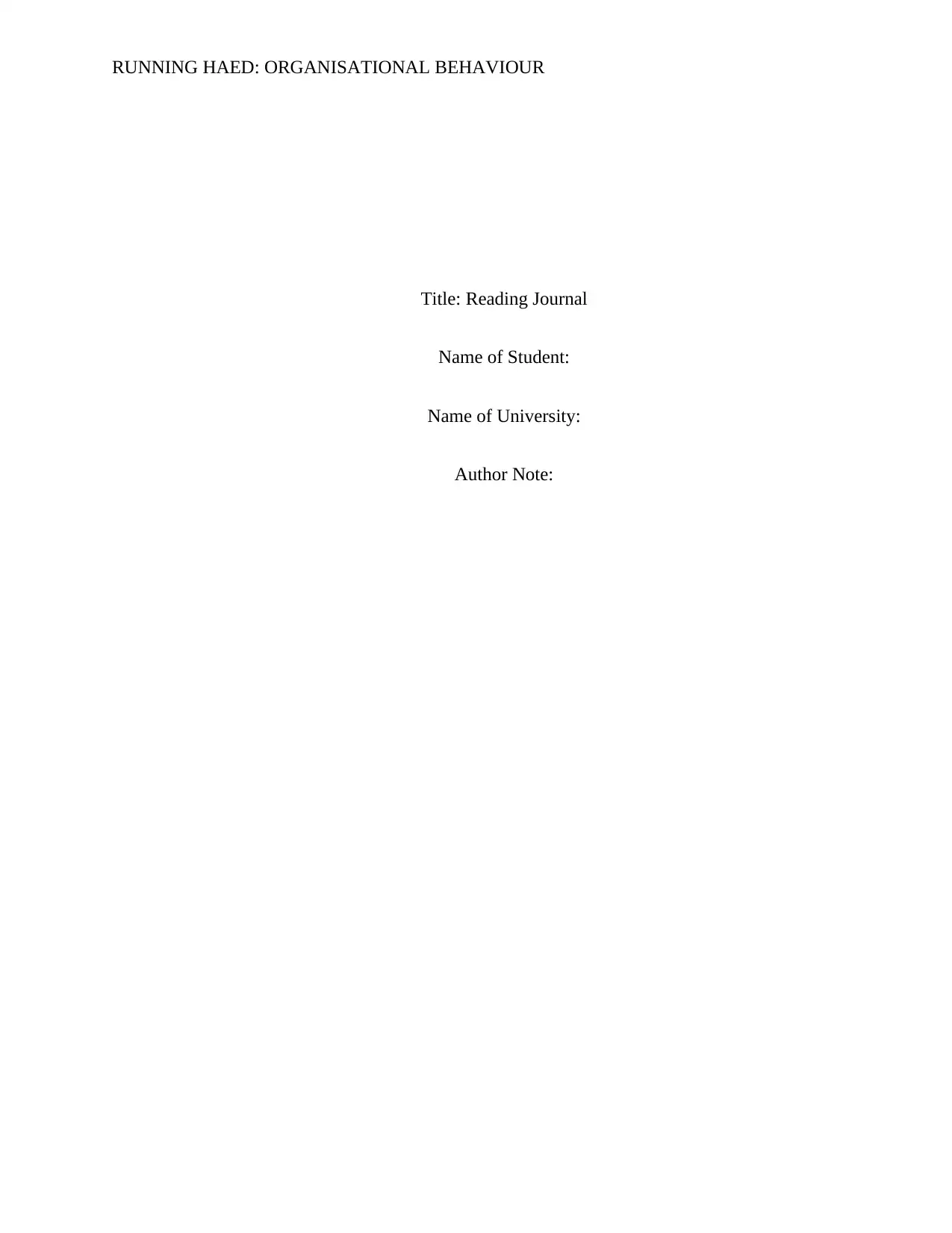
RUNNING HAED: ORGANISATIONAL BEHAVIOUR
Title: Reading Journal
Name of Student:
Name of University:
Author Note:
Title: Reading Journal
Name of Student:
Name of University:
Author Note:
Paraphrase This Document
Need a fresh take? Get an instant paraphrase of this document with our AI Paraphraser
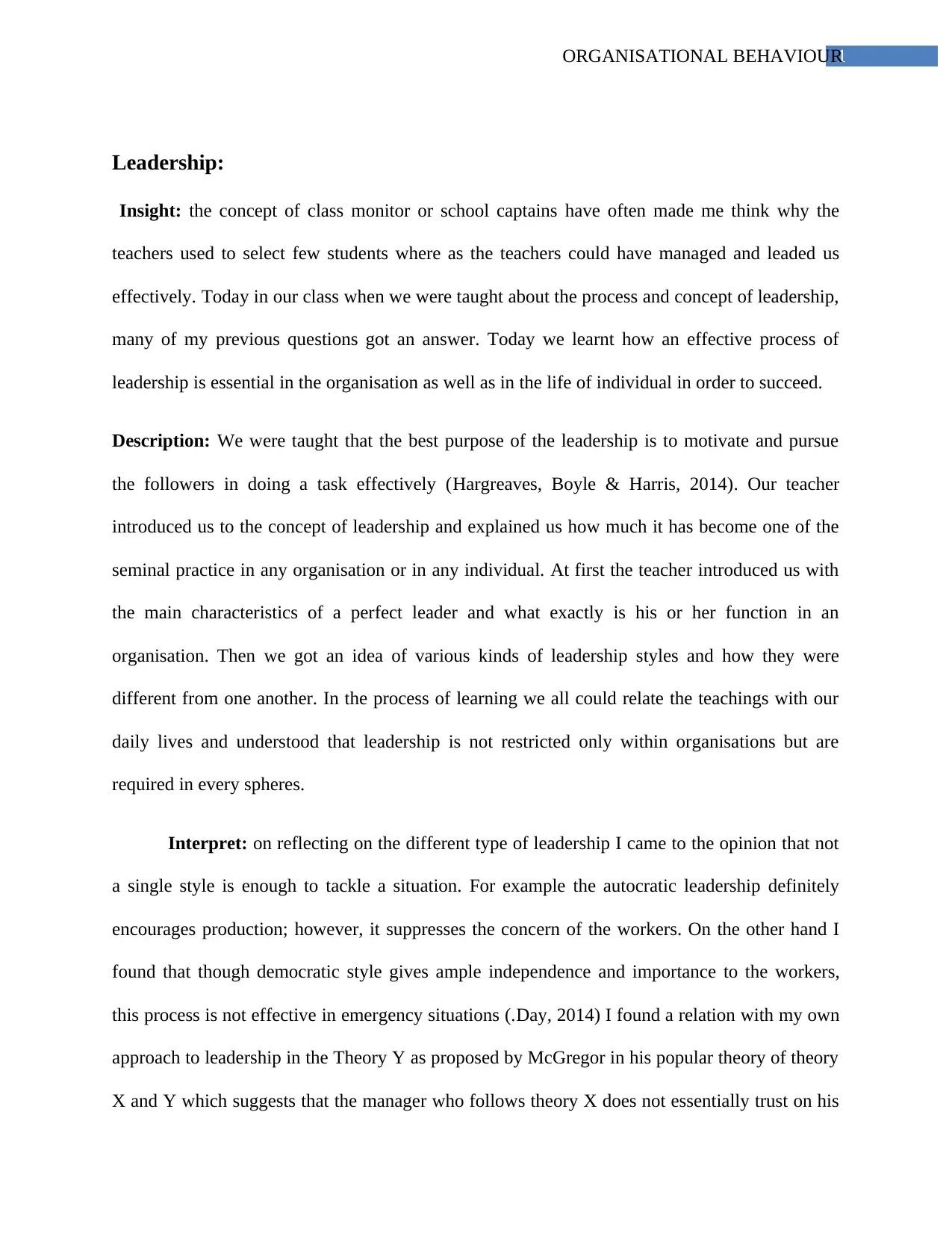
1ORGANISATIONAL BEHAVIOUR
Leadership:
Insight: the concept of class monitor or school captains have often made me think why the
teachers used to select few students where as the teachers could have managed and leaded us
effectively. Today in our class when we were taught about the process and concept of leadership,
many of my previous questions got an answer. Today we learnt how an effective process of
leadership is essential in the organisation as well as in the life of individual in order to succeed.
Description: We were taught that the best purpose of the leadership is to motivate and pursue
the followers in doing a task effectively (Hargreaves, Boyle & Harris, 2014). Our teacher
introduced us to the concept of leadership and explained us how much it has become one of the
seminal practice in any organisation or in any individual. At first the teacher introduced us with
the main characteristics of a perfect leader and what exactly is his or her function in an
organisation. Then we got an idea of various kinds of leadership styles and how they were
different from one another. In the process of learning we all could relate the teachings with our
daily lives and understood that leadership is not restricted only within organisations but are
required in every spheres.
Interpret: on reflecting on the different type of leadership I came to the opinion that not
a single style is enough to tackle a situation. For example the autocratic leadership definitely
encourages production; however, it suppresses the concern of the workers. On the other hand I
found that though democratic style gives ample independence and importance to the workers,
this process is not effective in emergency situations (.Day, 2014) I found a relation with my own
approach to leadership in the Theory Y as proposed by McGregor in his popular theory of theory
X and Y which suggests that the manager who follows theory X does not essentially trust on his
Leadership:
Insight: the concept of class monitor or school captains have often made me think why the
teachers used to select few students where as the teachers could have managed and leaded us
effectively. Today in our class when we were taught about the process and concept of leadership,
many of my previous questions got an answer. Today we learnt how an effective process of
leadership is essential in the organisation as well as in the life of individual in order to succeed.
Description: We were taught that the best purpose of the leadership is to motivate and pursue
the followers in doing a task effectively (Hargreaves, Boyle & Harris, 2014). Our teacher
introduced us to the concept of leadership and explained us how much it has become one of the
seminal practice in any organisation or in any individual. At first the teacher introduced us with
the main characteristics of a perfect leader and what exactly is his or her function in an
organisation. Then we got an idea of various kinds of leadership styles and how they were
different from one another. In the process of learning we all could relate the teachings with our
daily lives and understood that leadership is not restricted only within organisations but are
required in every spheres.
Interpret: on reflecting on the different type of leadership I came to the opinion that not
a single style is enough to tackle a situation. For example the autocratic leadership definitely
encourages production; however, it suppresses the concern of the workers. On the other hand I
found that though democratic style gives ample independence and importance to the workers,
this process is not effective in emergency situations (.Day, 2014) I found a relation with my own
approach to leadership in the Theory Y as proposed by McGregor in his popular theory of theory
X and Y which suggests that the manager who follows theory X does not essentially trust on his
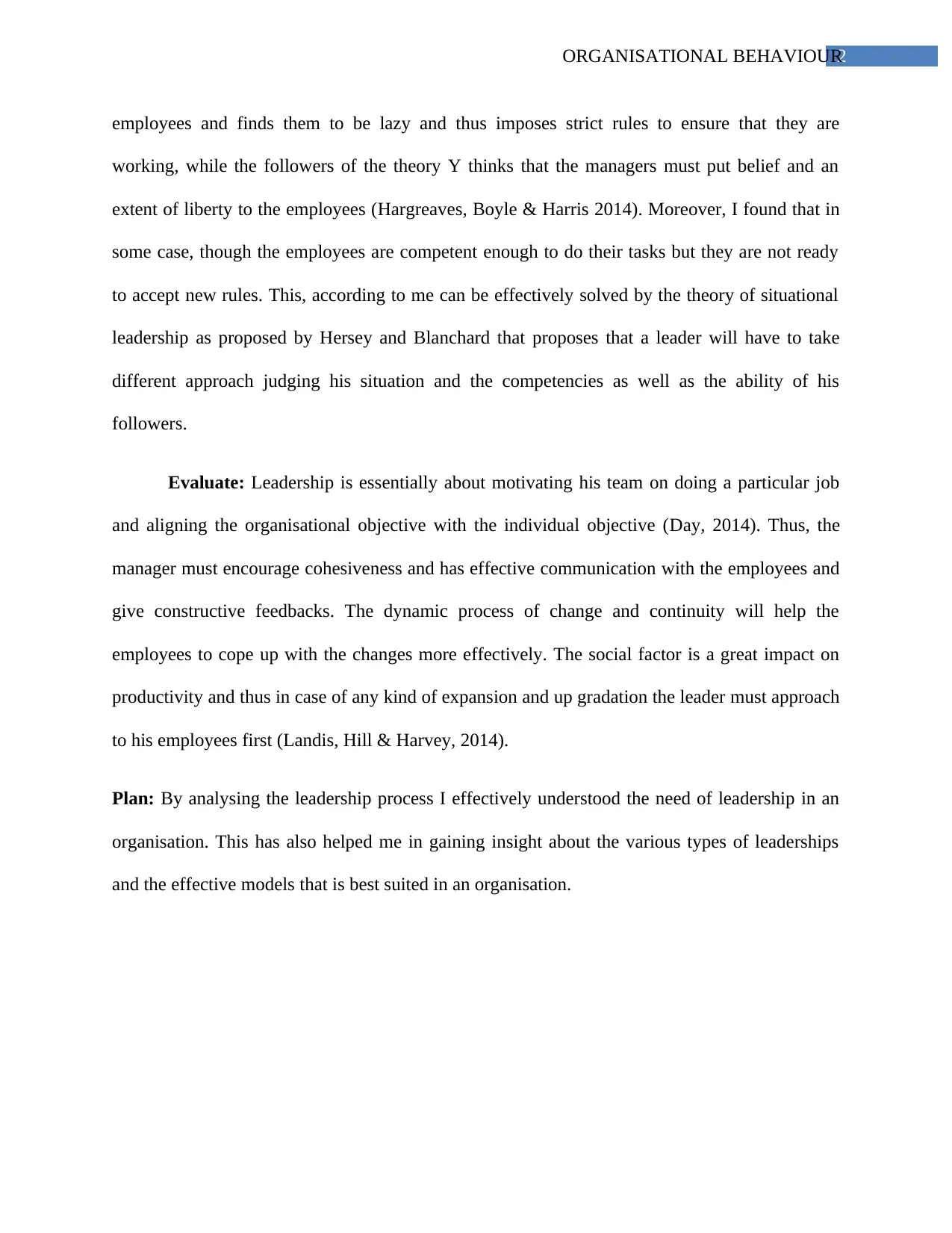
2ORGANISATIONAL BEHAVIOUR
employees and finds them to be lazy and thus imposes strict rules to ensure that they are
working, while the followers of the theory Y thinks that the managers must put belief and an
extent of liberty to the employees (Hargreaves, Boyle & Harris 2014). Moreover, I found that in
some case, though the employees are competent enough to do their tasks but they are not ready
to accept new rules. This, according to me can be effectively solved by the theory of situational
leadership as proposed by Hersey and Blanchard that proposes that a leader will have to take
different approach judging his situation and the competencies as well as the ability of his
followers.
Evaluate: Leadership is essentially about motivating his team on doing a particular job
and aligning the organisational objective with the individual objective (Day, 2014). Thus, the
manager must encourage cohesiveness and has effective communication with the employees and
give constructive feedbacks. The dynamic process of change and continuity will help the
employees to cope up with the changes more effectively. The social factor is a great impact on
productivity and thus in case of any kind of expansion and up gradation the leader must approach
to his employees first (Landis, Hill & Harvey, 2014).
Plan: By analysing the leadership process I effectively understood the need of leadership in an
organisation. This has also helped me in gaining insight about the various types of leaderships
and the effective models that is best suited in an organisation.
employees and finds them to be lazy and thus imposes strict rules to ensure that they are
working, while the followers of the theory Y thinks that the managers must put belief and an
extent of liberty to the employees (Hargreaves, Boyle & Harris 2014). Moreover, I found that in
some case, though the employees are competent enough to do their tasks but they are not ready
to accept new rules. This, according to me can be effectively solved by the theory of situational
leadership as proposed by Hersey and Blanchard that proposes that a leader will have to take
different approach judging his situation and the competencies as well as the ability of his
followers.
Evaluate: Leadership is essentially about motivating his team on doing a particular job
and aligning the organisational objective with the individual objective (Day, 2014). Thus, the
manager must encourage cohesiveness and has effective communication with the employees and
give constructive feedbacks. The dynamic process of change and continuity will help the
employees to cope up with the changes more effectively. The social factor is a great impact on
productivity and thus in case of any kind of expansion and up gradation the leader must approach
to his employees first (Landis, Hill & Harvey, 2014).
Plan: By analysing the leadership process I effectively understood the need of leadership in an
organisation. This has also helped me in gaining insight about the various types of leaderships
and the effective models that is best suited in an organisation.
⊘ This is a preview!⊘
Do you want full access?
Subscribe today to unlock all pages.

Trusted by 1+ million students worldwide
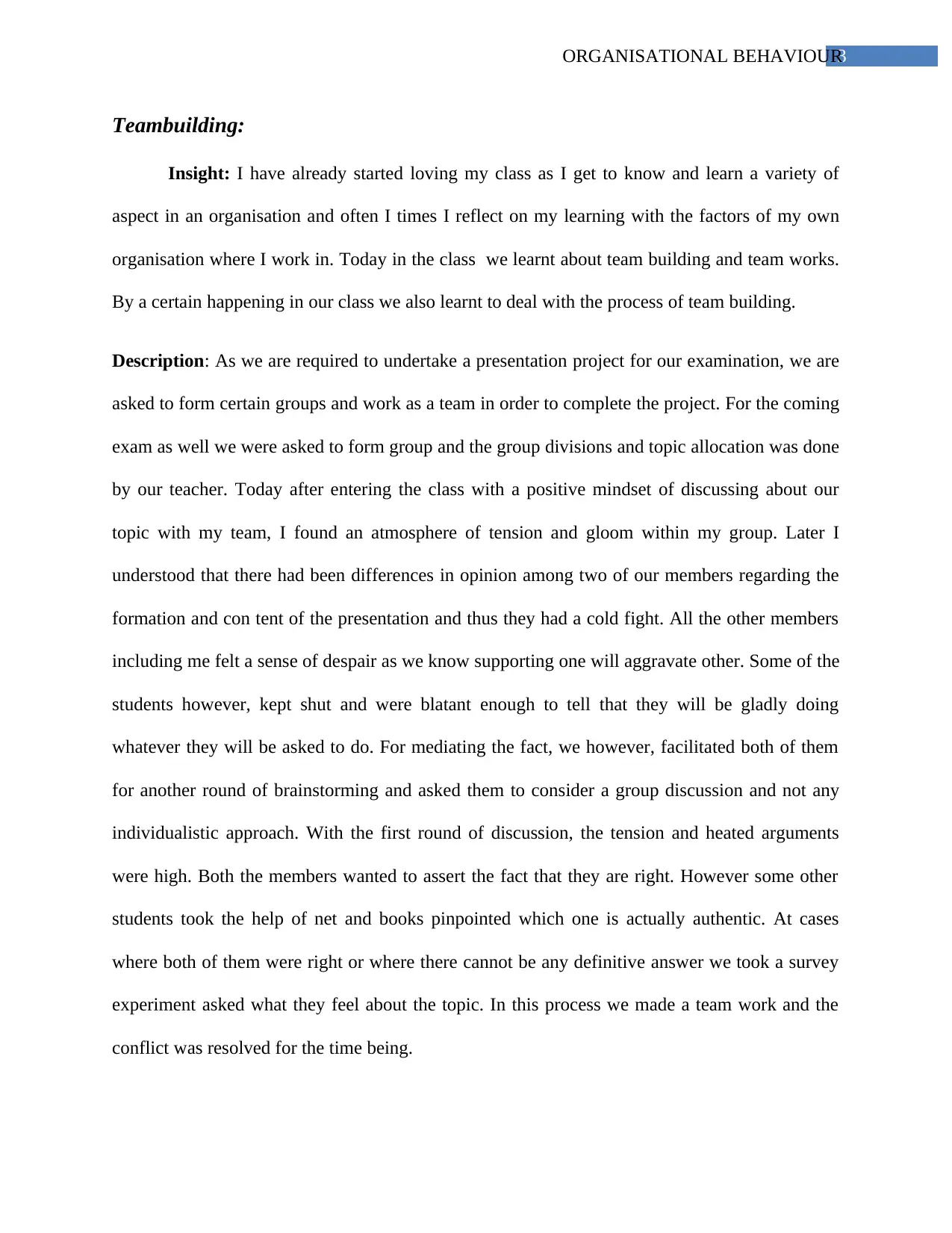
3ORGANISATIONAL BEHAVIOUR
Teambuilding:
Insight: I have already started loving my class as I get to know and learn a variety of
aspect in an organisation and often I times I reflect on my learning with the factors of my own
organisation where I work in. Today in the class we learnt about team building and team works.
By a certain happening in our class we also learnt to deal with the process of team building.
Description: As we are required to undertake a presentation project for our examination, we are
asked to form certain groups and work as a team in order to complete the project. For the coming
exam as well we were asked to form group and the group divisions and topic allocation was done
by our teacher. Today after entering the class with a positive mindset of discussing about our
topic with my team, I found an atmosphere of tension and gloom within my group. Later I
understood that there had been differences in opinion among two of our members regarding the
formation and con tent of the presentation and thus they had a cold fight. All the other members
including me felt a sense of despair as we know supporting one will aggravate other. Some of the
students however, kept shut and were blatant enough to tell that they will be gladly doing
whatever they will be asked to do. For mediating the fact, we however, facilitated both of them
for another round of brainstorming and asked them to consider a group discussion and not any
individualistic approach. With the first round of discussion, the tension and heated arguments
were high. Both the members wanted to assert the fact that they are right. However some other
students took the help of net and books pinpointed which one is actually authentic. At cases
where both of them were right or where there cannot be any definitive answer we took a survey
experiment asked what they feel about the topic. In this process we made a team work and the
conflict was resolved for the time being.
Teambuilding:
Insight: I have already started loving my class as I get to know and learn a variety of
aspect in an organisation and often I times I reflect on my learning with the factors of my own
organisation where I work in. Today in the class we learnt about team building and team works.
By a certain happening in our class we also learnt to deal with the process of team building.
Description: As we are required to undertake a presentation project for our examination, we are
asked to form certain groups and work as a team in order to complete the project. For the coming
exam as well we were asked to form group and the group divisions and topic allocation was done
by our teacher. Today after entering the class with a positive mindset of discussing about our
topic with my team, I found an atmosphere of tension and gloom within my group. Later I
understood that there had been differences in opinion among two of our members regarding the
formation and con tent of the presentation and thus they had a cold fight. All the other members
including me felt a sense of despair as we know supporting one will aggravate other. Some of the
students however, kept shut and were blatant enough to tell that they will be gladly doing
whatever they will be asked to do. For mediating the fact, we however, facilitated both of them
for another round of brainstorming and asked them to consider a group discussion and not any
individualistic approach. With the first round of discussion, the tension and heated arguments
were high. Both the members wanted to assert the fact that they are right. However some other
students took the help of net and books pinpointed which one is actually authentic. At cases
where both of them were right or where there cannot be any definitive answer we took a survey
experiment asked what they feel about the topic. In this process we made a team work and the
conflict was resolved for the time being.
Paraphrase This Document
Need a fresh take? Get an instant paraphrase of this document with our AI Paraphraser
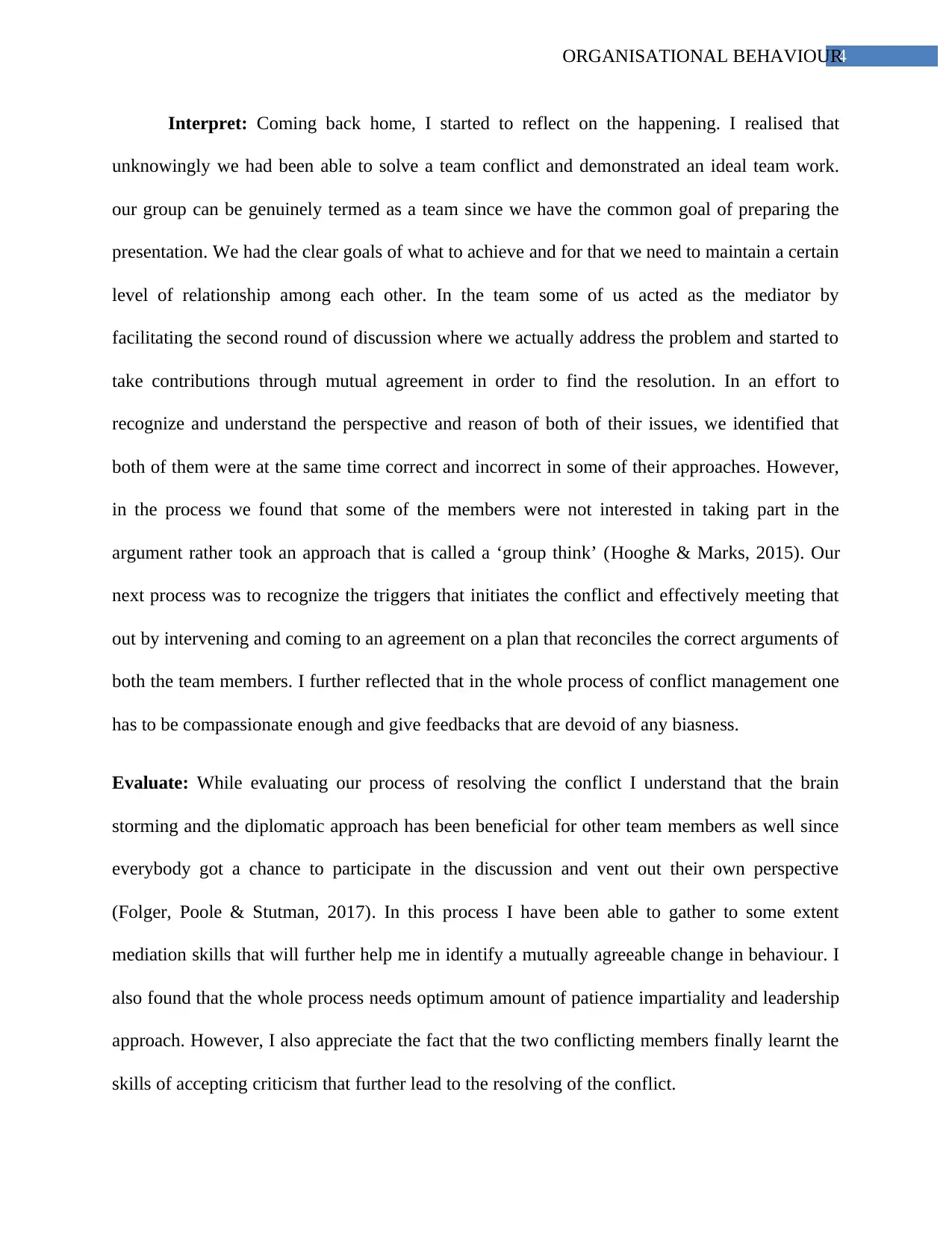
4ORGANISATIONAL BEHAVIOUR
Interpret: Coming back home, I started to reflect on the happening. I realised that
unknowingly we had been able to solve a team conflict and demonstrated an ideal team work.
our group can be genuinely termed as a team since we have the common goal of preparing the
presentation. We had the clear goals of what to achieve and for that we need to maintain a certain
level of relationship among each other. In the team some of us acted as the mediator by
facilitating the second round of discussion where we actually address the problem and started to
take contributions through mutual agreement in order to find the resolution. In an effort to
recognize and understand the perspective and reason of both of their issues, we identified that
both of them were at the same time correct and incorrect in some of their approaches. However,
in the process we found that some of the members were not interested in taking part in the
argument rather took an approach that is called a ‘group think’ (Hooghe & Marks, 2015). Our
next process was to recognize the triggers that initiates the conflict and effectively meeting that
out by intervening and coming to an agreement on a plan that reconciles the correct arguments of
both the team members. I further reflected that in the whole process of conflict management one
has to be compassionate enough and give feedbacks that are devoid of any biasness.
Evaluate: While evaluating our process of resolving the conflict I understand that the brain
storming and the diplomatic approach has been beneficial for other team members as well since
everybody got a chance to participate in the discussion and vent out their own perspective
(Folger, Poole & Stutman, 2017). In this process I have been able to gather to some extent
mediation skills that will further help me in identify a mutually agreeable change in behaviour. I
also found that the whole process needs optimum amount of patience impartiality and leadership
approach. However, I also appreciate the fact that the two conflicting members finally learnt the
skills of accepting criticism that further lead to the resolving of the conflict.
Interpret: Coming back home, I started to reflect on the happening. I realised that
unknowingly we had been able to solve a team conflict and demonstrated an ideal team work.
our group can be genuinely termed as a team since we have the common goal of preparing the
presentation. We had the clear goals of what to achieve and for that we need to maintain a certain
level of relationship among each other. In the team some of us acted as the mediator by
facilitating the second round of discussion where we actually address the problem and started to
take contributions through mutual agreement in order to find the resolution. In an effort to
recognize and understand the perspective and reason of both of their issues, we identified that
both of them were at the same time correct and incorrect in some of their approaches. However,
in the process we found that some of the members were not interested in taking part in the
argument rather took an approach that is called a ‘group think’ (Hooghe & Marks, 2015). Our
next process was to recognize the triggers that initiates the conflict and effectively meeting that
out by intervening and coming to an agreement on a plan that reconciles the correct arguments of
both the team members. I further reflected that in the whole process of conflict management one
has to be compassionate enough and give feedbacks that are devoid of any biasness.
Evaluate: While evaluating our process of resolving the conflict I understand that the brain
storming and the diplomatic approach has been beneficial for other team members as well since
everybody got a chance to participate in the discussion and vent out their own perspective
(Folger, Poole & Stutman, 2017). In this process I have been able to gather to some extent
mediation skills that will further help me in identify a mutually agreeable change in behaviour. I
also found that the whole process needs optimum amount of patience impartiality and leadership
approach. However, I also appreciate the fact that the two conflicting members finally learnt the
skills of accepting criticism that further lead to the resolving of the conflict.
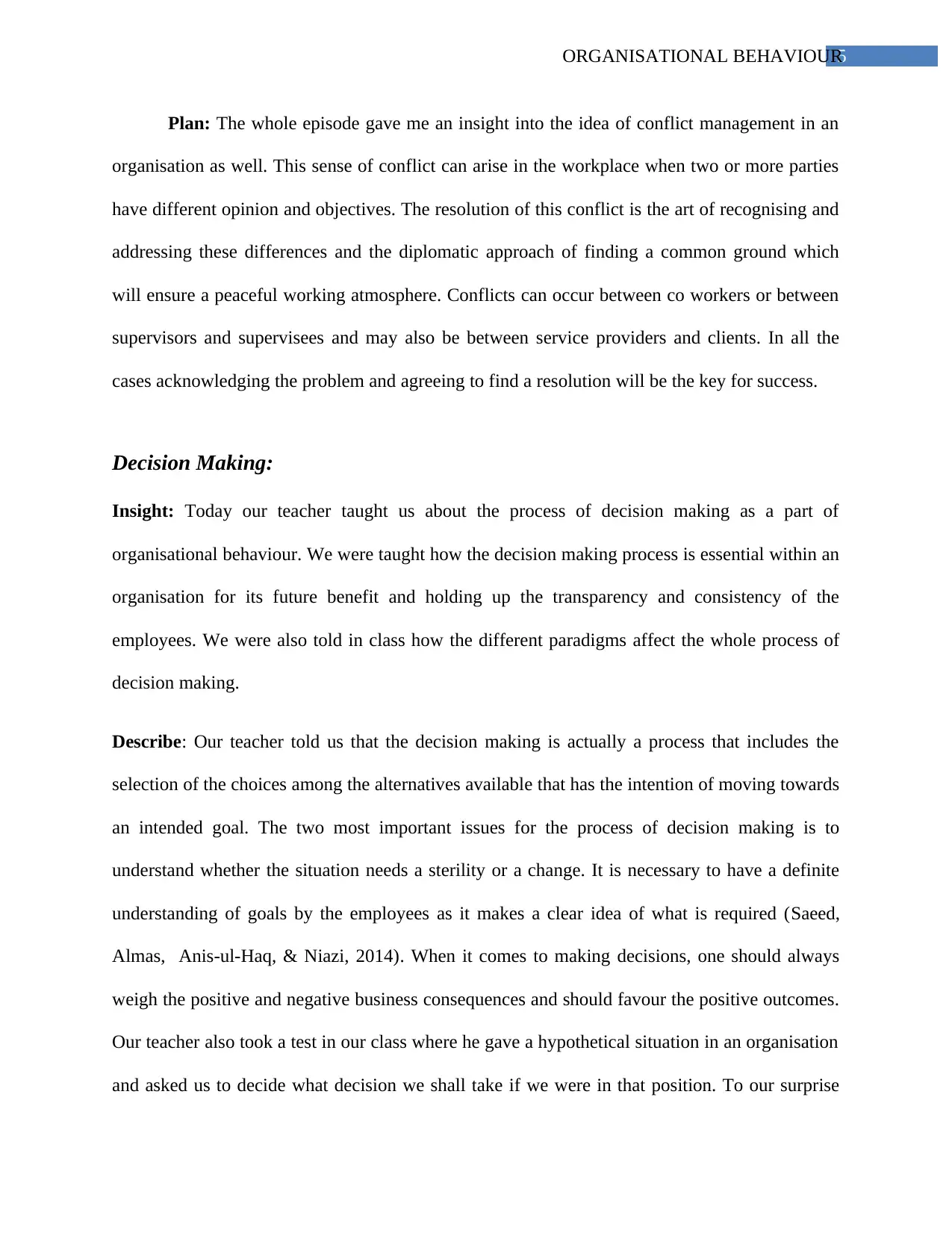
5ORGANISATIONAL BEHAVIOUR
Plan: The whole episode gave me an insight into the idea of conflict management in an
organisation as well. This sense of conflict can arise in the workplace when two or more parties
have different opinion and objectives. The resolution of this conflict is the art of recognising and
addressing these differences and the diplomatic approach of finding a common ground which
will ensure a peaceful working atmosphere. Conflicts can occur between co workers or between
supervisors and supervisees and may also be between service providers and clients. In all the
cases acknowledging the problem and agreeing to find a resolution will be the key for success.
Decision Making:
Insight: Today our teacher taught us about the process of decision making as a part of
organisational behaviour. We were taught how the decision making process is essential within an
organisation for its future benefit and holding up the transparency and consistency of the
employees. We were also told in class how the different paradigms affect the whole process of
decision making.
Describe: Our teacher told us that the decision making is actually a process that includes the
selection of the choices among the alternatives available that has the intention of moving towards
an intended goal. The two most important issues for the process of decision making is to
understand whether the situation needs a sterility or a change. It is necessary to have a definite
understanding of goals by the employees as it makes a clear idea of what is required (Saeed,
Almas, Anis-ul-Haq, & Niazi, 2014). When it comes to making decisions, one should always
weigh the positive and negative business consequences and should favour the positive outcomes.
Our teacher also took a test in our class where he gave a hypothetical situation in an organisation
and asked us to decide what decision we shall take if we were in that position. To our surprise
Plan: The whole episode gave me an insight into the idea of conflict management in an
organisation as well. This sense of conflict can arise in the workplace when two or more parties
have different opinion and objectives. The resolution of this conflict is the art of recognising and
addressing these differences and the diplomatic approach of finding a common ground which
will ensure a peaceful working atmosphere. Conflicts can occur between co workers or between
supervisors and supervisees and may also be between service providers and clients. In all the
cases acknowledging the problem and agreeing to find a resolution will be the key for success.
Decision Making:
Insight: Today our teacher taught us about the process of decision making as a part of
organisational behaviour. We were taught how the decision making process is essential within an
organisation for its future benefit and holding up the transparency and consistency of the
employees. We were also told in class how the different paradigms affect the whole process of
decision making.
Describe: Our teacher told us that the decision making is actually a process that includes the
selection of the choices among the alternatives available that has the intention of moving towards
an intended goal. The two most important issues for the process of decision making is to
understand whether the situation needs a sterility or a change. It is necessary to have a definite
understanding of goals by the employees as it makes a clear idea of what is required (Saeed,
Almas, Anis-ul-Haq, & Niazi, 2014). When it comes to making decisions, one should always
weigh the positive and negative business consequences and should favour the positive outcomes.
Our teacher also took a test in our class where he gave a hypothetical situation in an organisation
and asked us to decide what decision we shall take if we were in that position. To our surprise
⊘ This is a preview!⊘
Do you want full access?
Subscribe today to unlock all pages.

Trusted by 1+ million students worldwide
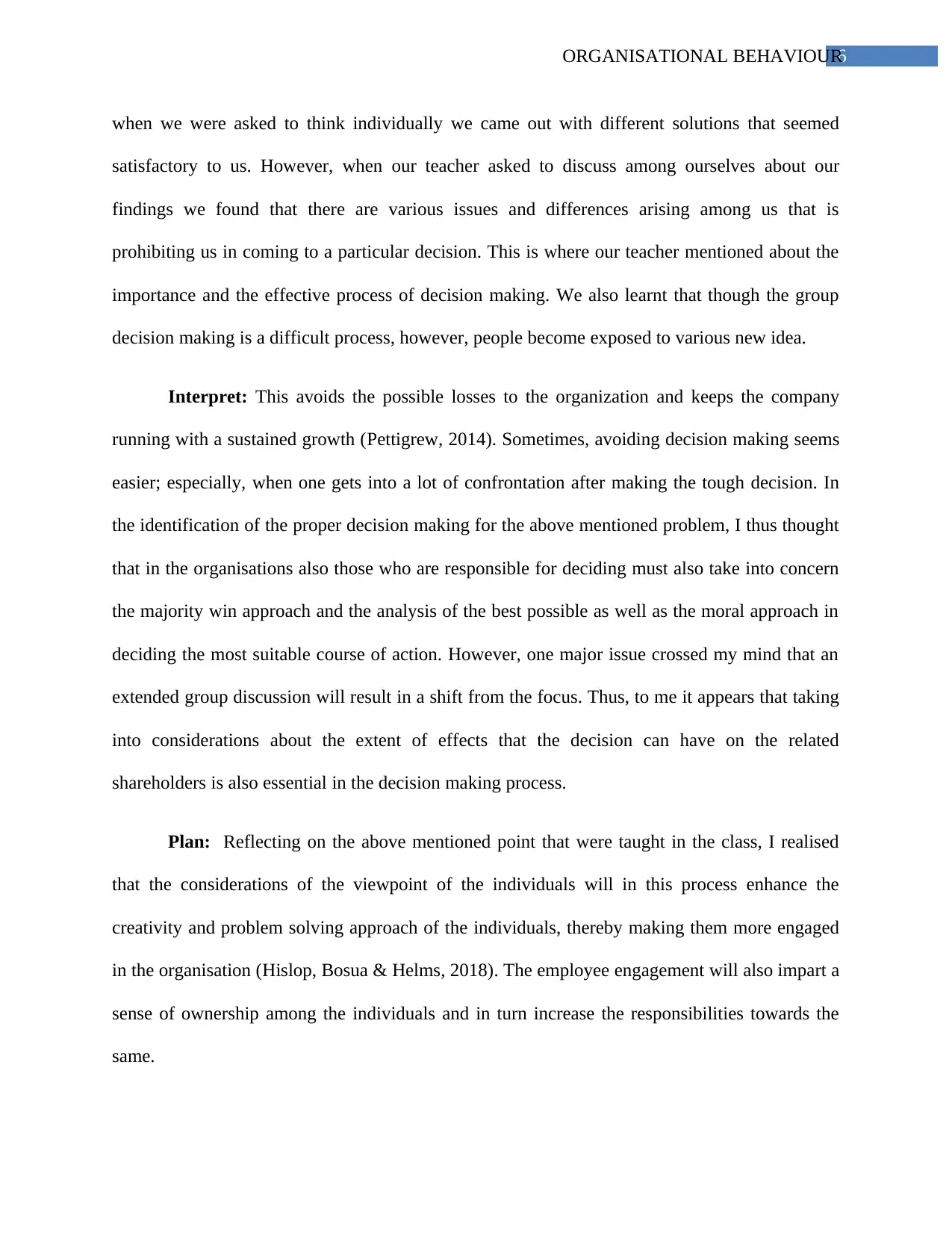
6ORGANISATIONAL BEHAVIOUR
when we were asked to think individually we came out with different solutions that seemed
satisfactory to us. However, when our teacher asked to discuss among ourselves about our
findings we found that there are various issues and differences arising among us that is
prohibiting us in coming to a particular decision. This is where our teacher mentioned about the
importance and the effective process of decision making. We also learnt that though the group
decision making is a difficult process, however, people become exposed to various new idea.
Interpret: This avoids the possible losses to the organization and keeps the company
running with a sustained growth (Pettigrew, 2014). Sometimes, avoiding decision making seems
easier; especially, when one gets into a lot of confrontation after making the tough decision. In
the identification of the proper decision making for the above mentioned problem, I thus thought
that in the organisations also those who are responsible for deciding must also take into concern
the majority win approach and the analysis of the best possible as well as the moral approach in
deciding the most suitable course of action. However, one major issue crossed my mind that an
extended group discussion will result in a shift from the focus. Thus, to me it appears that taking
into considerations about the extent of effects that the decision can have on the related
shareholders is also essential in the decision making process.
Plan: Reflecting on the above mentioned point that were taught in the class, I realised
that the considerations of the viewpoint of the individuals will in this process enhance the
creativity and problem solving approach of the individuals, thereby making them more engaged
in the organisation (Hislop, Bosua & Helms, 2018). The employee engagement will also impart a
sense of ownership among the individuals and in turn increase the responsibilities towards the
same.
when we were asked to think individually we came out with different solutions that seemed
satisfactory to us. However, when our teacher asked to discuss among ourselves about our
findings we found that there are various issues and differences arising among us that is
prohibiting us in coming to a particular decision. This is where our teacher mentioned about the
importance and the effective process of decision making. We also learnt that though the group
decision making is a difficult process, however, people become exposed to various new idea.
Interpret: This avoids the possible losses to the organization and keeps the company
running with a sustained growth (Pettigrew, 2014). Sometimes, avoiding decision making seems
easier; especially, when one gets into a lot of confrontation after making the tough decision. In
the identification of the proper decision making for the above mentioned problem, I thus thought
that in the organisations also those who are responsible for deciding must also take into concern
the majority win approach and the analysis of the best possible as well as the moral approach in
deciding the most suitable course of action. However, one major issue crossed my mind that an
extended group discussion will result in a shift from the focus. Thus, to me it appears that taking
into considerations about the extent of effects that the decision can have on the related
shareholders is also essential in the decision making process.
Plan: Reflecting on the above mentioned point that were taught in the class, I realised
that the considerations of the viewpoint of the individuals will in this process enhance the
creativity and problem solving approach of the individuals, thereby making them more engaged
in the organisation (Hislop, Bosua & Helms, 2018). The employee engagement will also impart a
sense of ownership among the individuals and in turn increase the responsibilities towards the
same.
Paraphrase This Document
Need a fresh take? Get an instant paraphrase of this document with our AI Paraphraser

7ORGANISATIONAL BEHAVIOUR
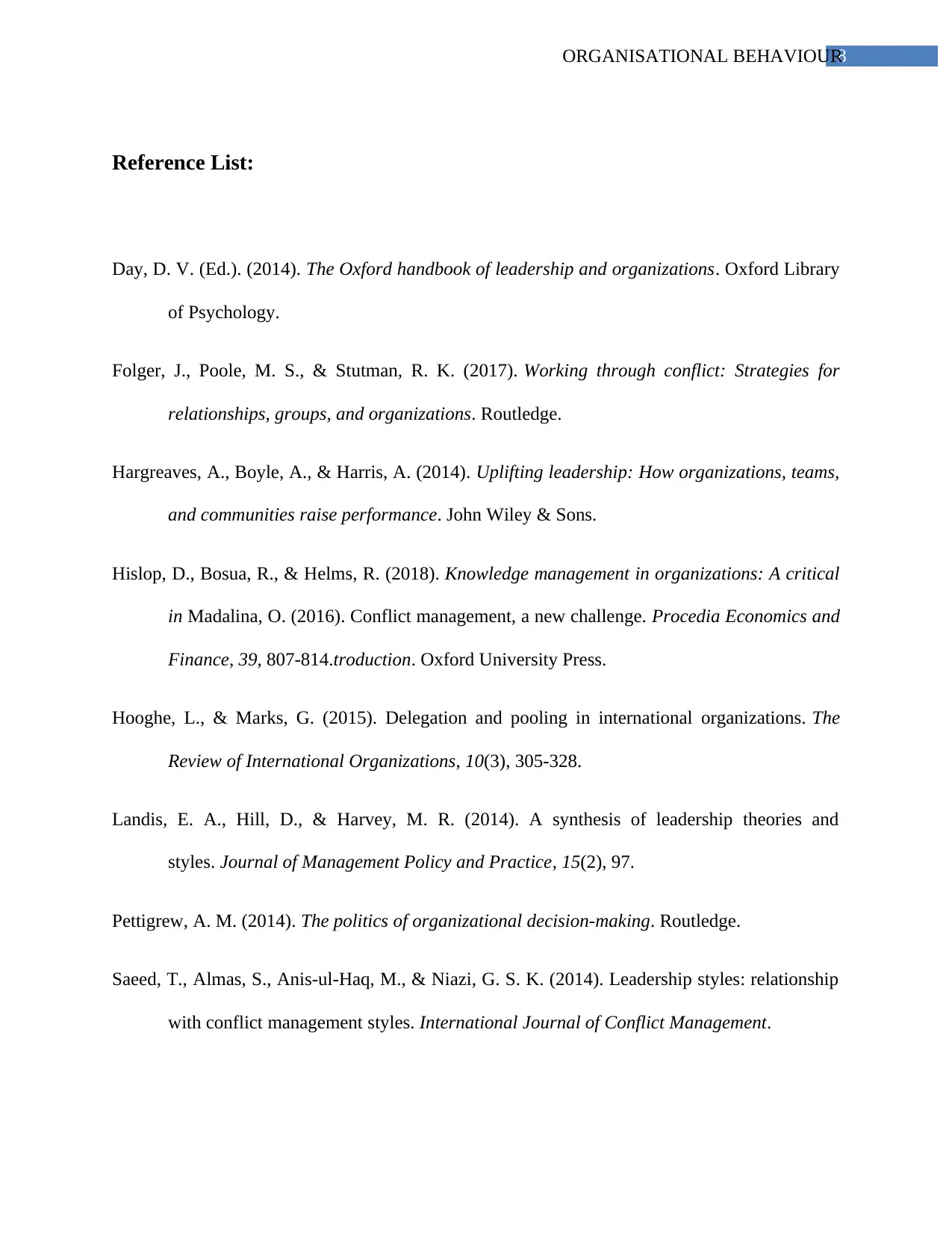
8ORGANISATIONAL BEHAVIOUR
Reference List:
Day, D. V. (Ed.). (2014). The Oxford handbook of leadership and organizations. Oxford Library
of Psychology.
Folger, J., Poole, M. S., & Stutman, R. K. (2017). Working through conflict: Strategies for
relationships, groups, and organizations. Routledge.
Hargreaves, A., Boyle, A., & Harris, A. (2014). Uplifting leadership: How organizations, teams,
and communities raise performance. John Wiley & Sons.
Hislop, D., Bosua, R., & Helms, R. (2018). Knowledge management in organizations: A critical
in Madalina, O. (2016). Conflict management, a new challenge. Procedia Economics and
Finance, 39, 807-814.troduction. Oxford University Press.
Hooghe, L., & Marks, G. (2015). Delegation and pooling in international organizations. The
Review of International Organizations, 10(3), 305-328.
Landis, E. A., Hill, D., & Harvey, M. R. (2014). A synthesis of leadership theories and
styles. Journal of Management Policy and Practice, 15(2), 97.
Pettigrew, A. M. (2014). The politics of organizational decision-making. Routledge.
Saeed, T., Almas, S., Anis-ul-Haq, M., & Niazi, G. S. K. (2014). Leadership styles: relationship
with conflict management styles. International Journal of Conflict Management.
Reference List:
Day, D. V. (Ed.). (2014). The Oxford handbook of leadership and organizations. Oxford Library
of Psychology.
Folger, J., Poole, M. S., & Stutman, R. K. (2017). Working through conflict: Strategies for
relationships, groups, and organizations. Routledge.
Hargreaves, A., Boyle, A., & Harris, A. (2014). Uplifting leadership: How organizations, teams,
and communities raise performance. John Wiley & Sons.
Hislop, D., Bosua, R., & Helms, R. (2018). Knowledge management in organizations: A critical
in Madalina, O. (2016). Conflict management, a new challenge. Procedia Economics and
Finance, 39, 807-814.troduction. Oxford University Press.
Hooghe, L., & Marks, G. (2015). Delegation and pooling in international organizations. The
Review of International Organizations, 10(3), 305-328.
Landis, E. A., Hill, D., & Harvey, M. R. (2014). A synthesis of leadership theories and
styles. Journal of Management Policy and Practice, 15(2), 97.
Pettigrew, A. M. (2014). The politics of organizational decision-making. Routledge.
Saeed, T., Almas, S., Anis-ul-Haq, M., & Niazi, G. S. K. (2014). Leadership styles: relationship
with conflict management styles. International Journal of Conflict Management.
⊘ This is a preview!⊘
Do you want full access?
Subscribe today to unlock all pages.

Trusted by 1+ million students worldwide
1 out of 9
Related Documents
Your All-in-One AI-Powered Toolkit for Academic Success.
+13062052269
info@desklib.com
Available 24*7 on WhatsApp / Email
![[object Object]](/_next/static/media/star-bottom.7253800d.svg)
Unlock your academic potential
Copyright © 2020–2025 A2Z Services. All Rights Reserved. Developed and managed by ZUCOL.




